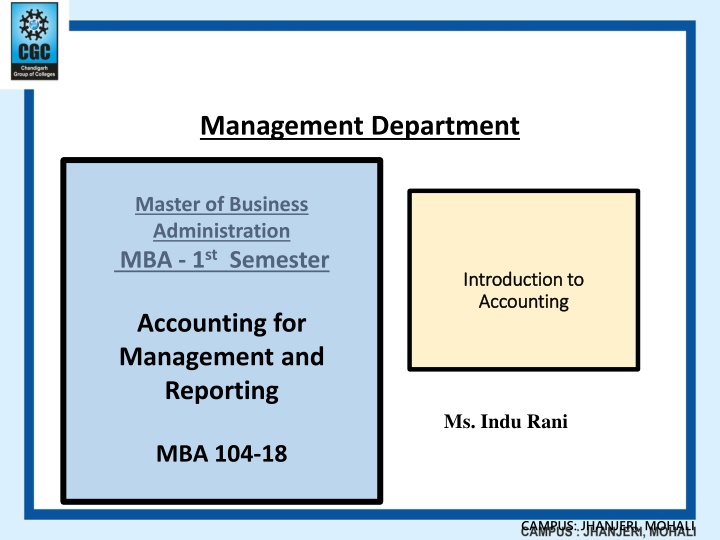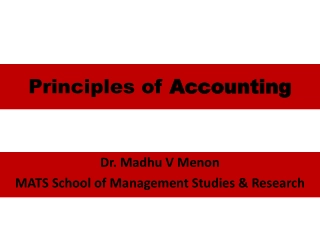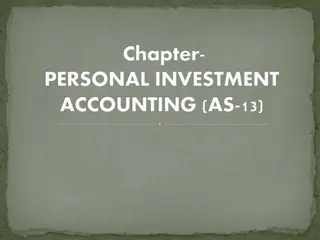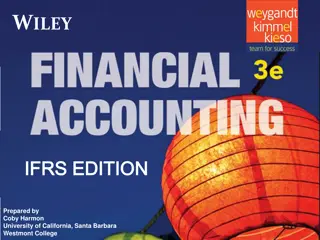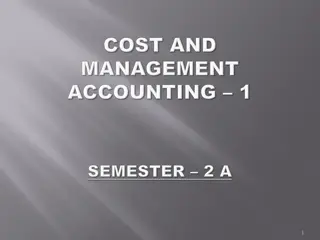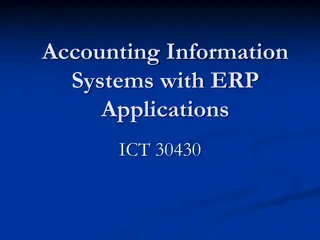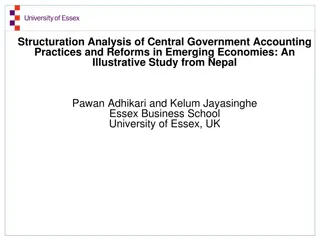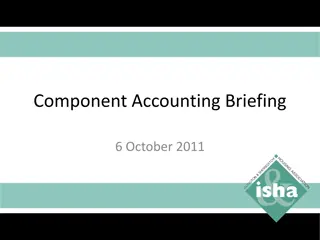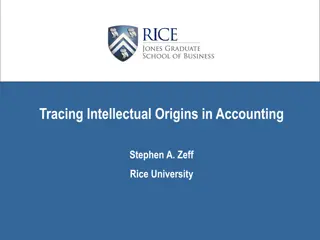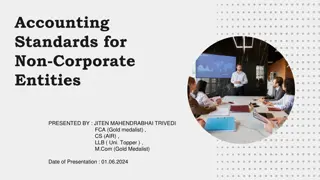Introduction to Accounting History and Importance
The historical origins of accounting, dating back thousands of years to Mesopotamian civilizations. Learn how accounting has evolved and its critical role in modern business decision-making. Discover the significance of bookkeeping and the definition of accounting in economic data interpretation.
Download Presentation

Please find below an Image/Link to download the presentation.
The content on the website is provided AS IS for your information and personal use only. It may not be sold, licensed, or shared on other websites without obtaining consent from the author.If you encounter any issues during the download, it is possible that the publisher has removed the file from their server.
You are allowed to download the files provided on this website for personal or commercial use, subject to the condition that they are used lawfully. All files are the property of their respective owners.
The content on the website is provided AS IS for your information and personal use only. It may not be sold, licensed, or shared on other websites without obtaining consent from the author.
E N D
Presentation Transcript
Management Department Master of Business Administration MBA - 1st Semester Introduction to Introduction to Accounting Accounting Accounting for Management and Reporting Ms. Indu Rani MBA 104-18 CAMPUS: JHANJERI, MOHALI
Introduction to Accounting Origin and Growth of accounting Accounting is a language that dates back thousands of years and has been used in many parts of the world. The earliest evidence of this language comes from Mesopotamian civilizations more than 7,000 years ago.The Mesopotamians kept the earliest records of goods traded and received, and these activities are related to the early record-keeping of the ancient Egyptians and Babylonians. The Mesopotamians used primitive accounting methods, keeping records that detailed transactions involving animals, livestock, and crops. In India, philosopher and economist Chanakya wrote Arthashastra during the Mauryan Empire around the second century B.C. The book contained advice and details on how to maintain record books for accounts.
Book-Keeping Meaning Bookkeeping is the process of recording all financial transactions made by a business. Bookkeepers are responsible for recording, classifying, and organizing every financial transaction that is made through the course of business operations.Bookkeeping is the process of keeping track of every financial transaction made by a business firm from the opening of the firm to the closing of the firm. Depending on the type of accounting system used by the business, each financial transaction is recorded based on supporting documentation. That documentation may be a receipt, an invoice, a purchase order, or some similar type of financial record showing that the transaction took place.
Meaning and definition of Accounting Accounting can be defined as a process of reporting, recording, interpreting and summarising economic data. The introduction of accounting helps the decision-makers of a company to make effective choices, by providing information on the financial status of the business. The American Institute of Certified Public Accountants (AICPA) had defined accounting as the art of recording, classifying, and summarising in a significant manner and in terms of money, transactions and events which are, in part at least, of financial character, and interpreting the results thereof .
Branches of Accounting and their Inter-relationship
Accounting as an Information system or Users of Accounting Information
Accounting concepts, conventions and principles
Accounting Principles Accounting principles are man made. A general law or rule, adopted or professed as a guide to action, a settled ground or basis of conduct or practice.
Features of accounting principles Relevance or usefulness: - Satisfies the needs of those who use it. - Able to provide useful information Objectivity : - Based on facts and figures - No scope for personal bias Feasibility : - Principles should be practicable - Easy to use otherwise their utility will be limited
GAAP Accounting being a man made system, must evolve and adjust itself to the changes in the needs of mankind. As a result, accounting principles are not as exact and rigid as are the laws of natural sciences. Therefore, emphasis is on general, instead of universal, acceptability of accounting principles. The GAAP are the building blocks of the accounting language. Rather, they are the pillars on which the structure of accounting is basically resting. 17
Classification of Accounting Principles Accounting Principles Concepts Conventions
Accounting Concepts Concepts include those basic assumptions or conditions upon which the science of accounting is based. Accounting concepts, conventions and principles have served as guidelines in the practice of accounting. Concept denotes logical consideration and notion which is generally and widely accepted. 19
Concepts 1. Business Entity Concept: o Business considered to be distinct from its owners-proprietors, partners or members. o Considered as two distinct and separate entities. o Transaction has to be recorded from point of view of business and not owners. o Cash contributed by the proprietor, for example, adds to the cash resources of the business and hence, is debited to Cash account, though it reduces the cash resources of the proprietor. The businessman is just like a creditor of the business. 2. Money measurement concept: o Only monetary transactions come under accounting framework. o Money is a common denominator. o A stable monetary unit to be adopted. 3. Going concern concept: o Business has an indefinite life. o Not end or liquidate in the near future. 20
4. Accounting period concept: o o 12 months considered as one accounting period. Reports the results of the activity undertaken in specificperiod . 5. Cost concept: o Asset is ordinarily recorded in the books at the price at which it was acquired i.e. at its cost price. o Though recorded in the books at cost, in the course of time, they become reduced in value on account of depreciation charges. o o Divides entire indefinite life of business into smaller periods. Known as historical cost concept. Assets do not reflect the real worth i.e. Price level changes 6. Dual aspect concept: o For every debit, there is a credit . o Two sided effect to the extent of same amount. o This concept has resulted in an accounting equation: Assets Liabilities = Proprietor s claim
7. Revenue Recognition Concept: o Profit should be considered only when realized. o No anticipated profit should be taken credit of. 8. Matching Concept: o Expenses should be matched to the revenue of the appropriate accounting period. o For Example- Salary paid in January 2011 relating to December 2010 should be treated as expenditure for the year 2010 and not 2011.
9. Accrual Concept: o Accrual is concerned with expected future cash receipts and payments. o Make record of all expenses and incomes relating to accounting period whether actual cash has been disbursed or received or not. o For e.g. purchases and sales of goods on credit, rent (not yet paid), salaries outstanding etc. 10. Stable monetary unit concept: o Purchasing power of monetary unit remains same throughout.
Accounting Conventions 1. Convention of disclosure: o Financial statements should disclose all material information clearly to the reader. o State the fact of change in accounting policies and methods (if any) 2. Convention of consistency: o Same accounting principles for preparing financial statements for different periods. o Policy once adopted must not be changed. o Only be changed by showing the fact in the annual report. o For e.g. - Depreciation
3. Convention of conservatism: o Cautious approach or policy of Play safe . oBe pessimistic. oAll losses must be provided but profits should not be anticipated. oPossibility of loss taken into account at the earliest. oProspect of profit ignored until it does not materialise. 4. Convention of materiality: oOnly significant transactions recorded. oInsignificant transactions should find no place in the books of accounts.
Role of an Accountant Financial Data Management Analysis And Advice Financial Report Preparation Regulatory and Reporting Compliance External Business Affiliations
Steps in Accounting Process Steps in Accounting Process
Exposure to format of schedule VI of Public Limited, Banking and Insurance Companies Introduction Schedule VI to the Companies Act, 1956 ( the Act ) provides the manner in which every company registered under the Act shall prepare its Balance Sheet, Statement of Profit and Loss and notes thereto. In the light of various economic and regulatory reforms that have taken place for companies over the last several years, there was a need for enhancing the disclosure requirements under the Old Schedule VI to the Act and harmonizing and synchronizing them with the notified Accounting Standards as applicable ( AS / Accounting Standard(s) ).
Exceptions in Schedule-VI Balance Sheet Balance in Branch / Division Balance in Suspense A/c Difference In Opening Balance Unadjusted Forex Gain or Loss
